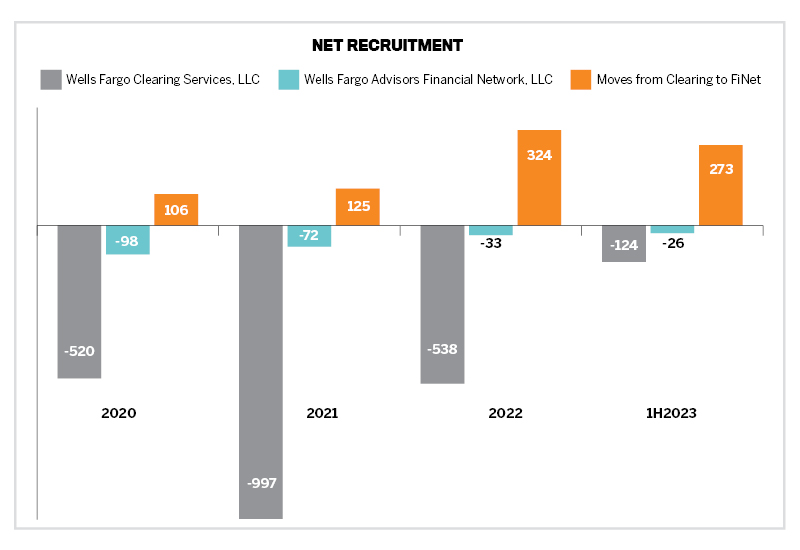

Wells Fargo Advisors, the broad marketing umbrella for close to 12,000 bank advisors, wealth management advisors and independent advisors, is betting big on its independent advisor business, in which an advisor works as either an independent contractor or registered investment advisor.
With thousands of financial advisors leaving or retiring from Wells Fargo since the banking scandals of 2016, the bank has turned to its independent business model, where advisors pocket a larger percentage of revenue, as a way to hang onto its veterans. Last summer, Wells Fargo took a big step in bolstering its independent broker-dealer, Wells Fargo Advisors Financial Network, known as FiNet, when it created a new bonus for advisors who would have otherwise lost hard-earned deferred compensation.
Senior Wells Fargo executives are touting the growth in FiNet and its RIA business.
“We really do believe that five years from now, the independent channel will be our biggest channel,” Barry Sommers, CEO of Wealth & Investment Management, said in an interview last month with Bloomberg News. “We’re not sitting there worrying about margins, we’re worrying about building the right platform for advisers and clients.”
InvestmentNews Research data make it clear that Wells Fargo has created an easier path for advisors to switch from Wells Fargo Clearing Services, the broker-dealer that's home to its 9,000 or so wealth management advisors, to FiNet.
What's not clear is how much revenue this is costing the firm; each Wells Fargo advisor generates on average near $1 million or more in annual revenue.
Independent contractor brokers or investment adviser reps typically capture 80 cents of each dollar of revenue they generate in fees and commissions; employee financial advisers can see on average 35 cents to 45 cents.

Since 2020, 828 financial advisors have moved from Wells Fargo Clearing Services to FiNet, with the pace accelerating in the past two years, bolstering Sommers' belief in the independent financial advisor side of the business. Those advisors represent $828 million in annual revenue, according to back-of-the-envelope math, so the stakes for Wells Fargo are high.
Wells Fargo is unique among its wirehouse bank competitors in this approach. While Merrill Lynch, Morgan Stanley and UBS likely have all discussed internally such an option for hanging onto their advisors, they've so far shied away from it.
The number of financial advisors at Wells Fargo moving internally to FiNet has only accelerated since the bank stopped cutting the deferred compensation of financial advisors who made that move. In 2022, 324 financial advisors moved from Wells Fargo Clearing Services to FiNet, according to InvestmentNews data, while 273 made that change in the first half of this year alone.
"The bank is trying to keep advisors who would have left anyway and keep revenue in house, although the revenue is less for the bank with an advisor at FiNet," said Danny Sarch, an industry recruiter. "The Wells Fargo name to the public is still a bit tainted. They're trying to keep the financial advisors tied to the company."
Wells Fargo Advisors has been criticized by the industry for making some of its advisors wait for almost a year to change to FiNet, but with the pace accelerating it appears the firm is making the transition easier.
"Wells is pursuing a strategy of full-service broker-dealer through the independent channel," said an executive at another firm who asked not to be named. "And it's a pretty reasonable strategy to say, 'If I’m going to lose all of the economic benefits of these financial advisors, why don't I try to keep some?' It also feels like the bank is largely putting the brand issues from several years back behind them."
Wells Fargo’s problems started in September 2016 with the news that Wells Fargo bank employees had secretly created millions of unauthorized accounts in customers' names without their consent. Thousands of financial advisors either left the bank to work elsewhere or simply retired.
Meanwhile, the competition for the advisors at Wells Fargo is intense. For example, Wells Fargo Advisors former chief David Kowach, who left the firm last year, has set up his own firm &Partners and recently recruited a Wells Fargo team.
According to the Bloomberg News article, Sommers said that over the past few years, the bank has invested $1 billion in its wealth management business. The goal is to gain market share, he noted.
"Our scale and breadth of investment, lending, and cash management capabilities, along with significant tech improvements, makes us a leading choice for advisors choosing independence," John Tyers, head of Wells Fargo's independent advisor group, wrote in an email. "As a result of our enhanced recruiting model, we’ve seen substantial growth and momentum in attracting external advisors to our independent channel, in addition to our internal transfers who launch their own businesses.”

By listening for what truly matters and where clients want to make a difference, advisors can avoid politics and help build more personal strategies.

JPMorgan and RBC have also welcomed ex-UBS advisors in Texas, while Steward Partners and SpirePoint make new additions in the Sun Belt.

Counsel representing Lisa Cook argued the president's pattern of publicly blasting the Fed calls the foundation for her firing into question.

The two firms violated the Advisers Act and Reg BI by making misleading statements and failing to disclose conflicts to retail and retirement plan investors, according to the regulator.

Elsewhere, two breakaway teams from Morgan Stanley and Merrill unite to form a $2 billion RIA, while a Texas-based independent merges with a Bay Area advisory practice.
Orion's Tom Wilson on delivering coordinated, high-touch service in a world where returns alone no longer set you apart.
Barely a decade old, registered index-linked annuities have quickly surged in popularity, thanks to their unique blend of protection and growth potential—an appealing option for investors looking to chart a steadier course through today's choppy market waters, says Myles Lambert, Brighthouse Financial.
